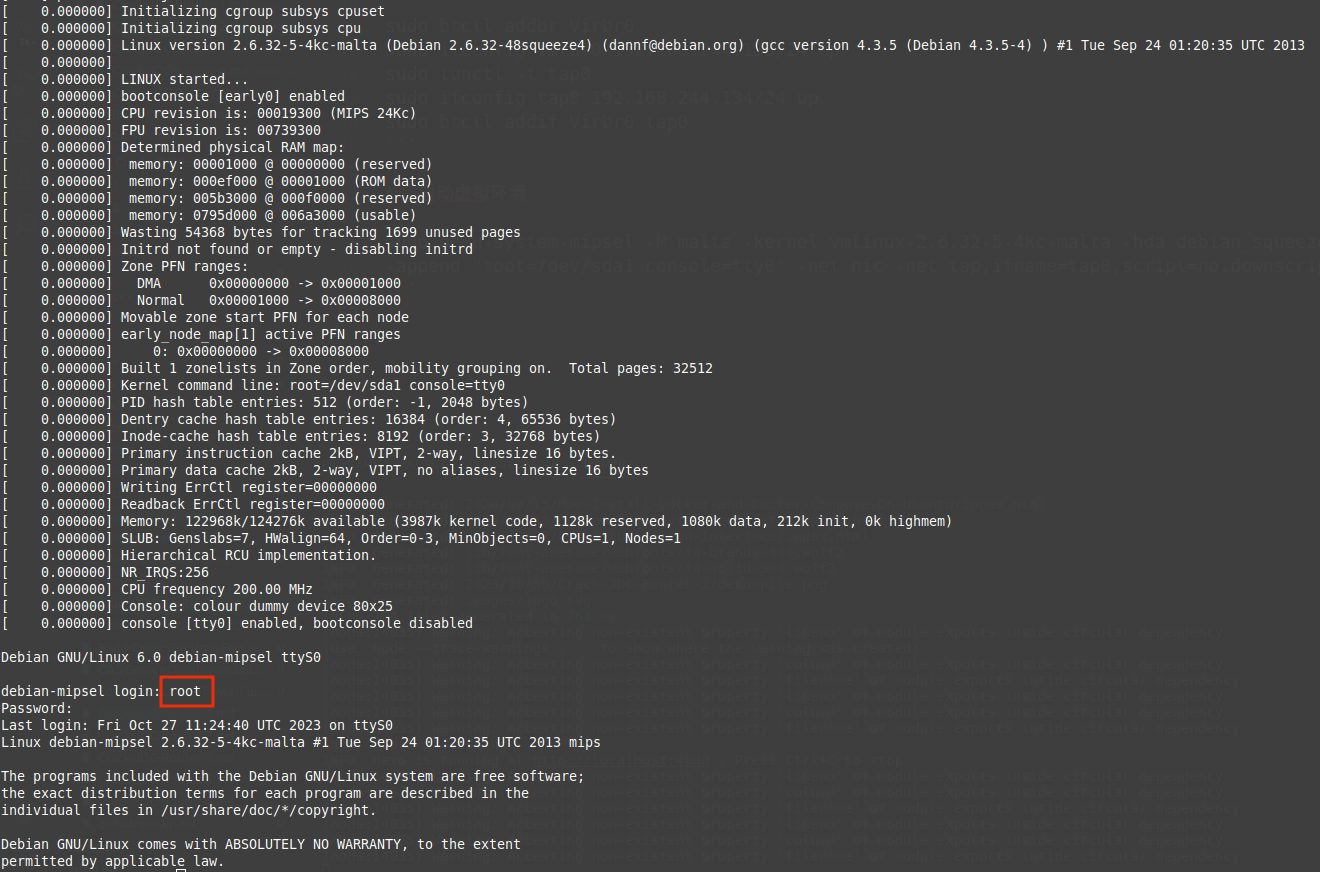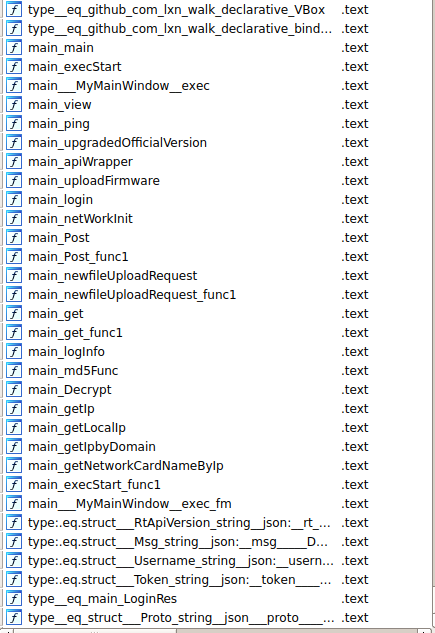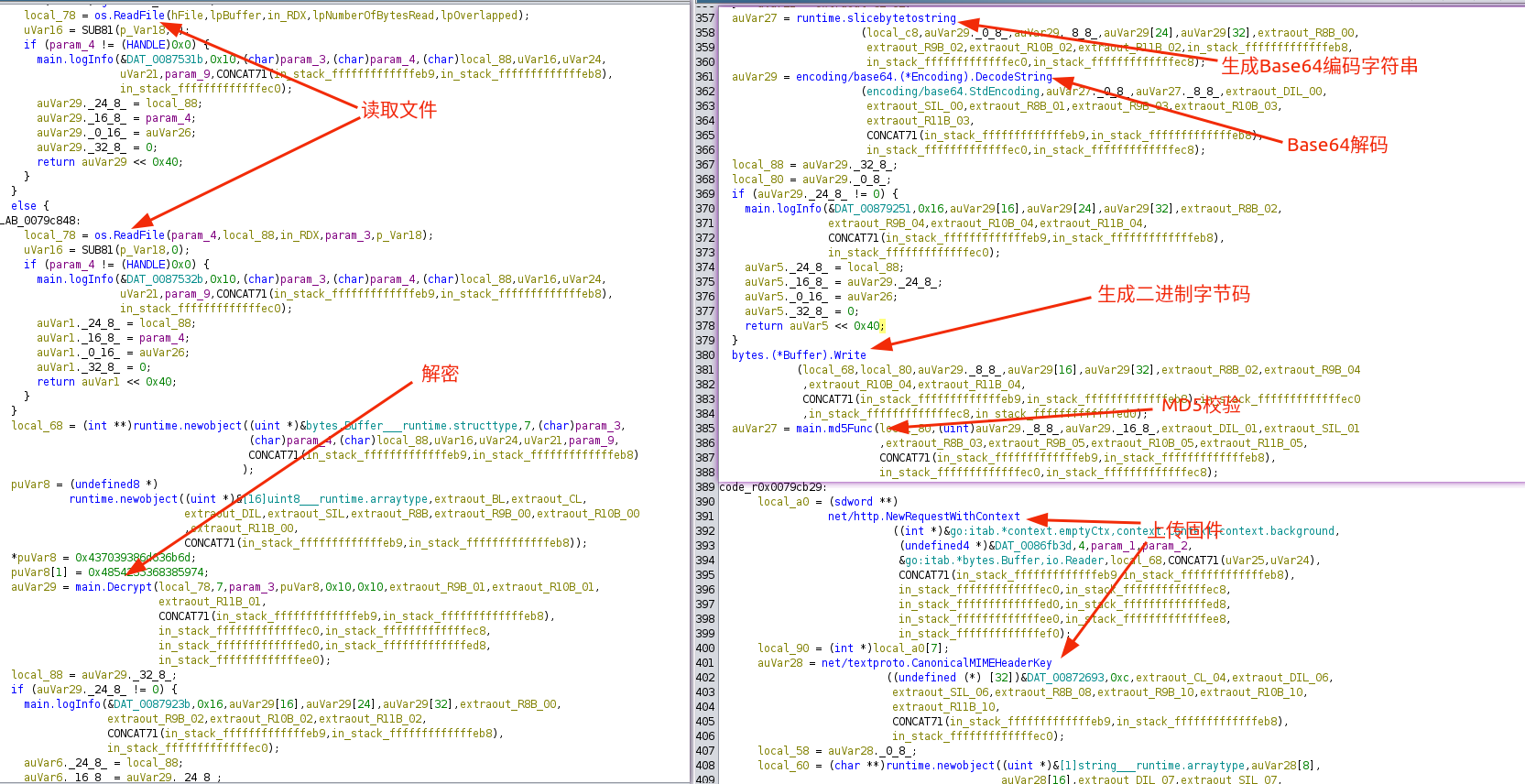1
2
3
4
5
6
7
8
9
10
11
12
13
14
15
16
17
18
19
20
21
22
23
24
25
26
27
28
29
30
31
32
33
34
35
36
37
38
39
40
41
42
43
44
45
46
47
48
49
50
51
52
53
54
55
56
57
58
59
60
61
62
63
64
65
66
67
68
69
70
71
72
73
74
75
76
77
78
79
80
81
82
83
84
85
86
87
88
89
90
91
92
93
94
95
96
97
98
99
100
101
102
103
104
105
106
107
108
109
110
111
112
113
114
115
116
117
118
119
120
121
122
123
124
125
126
127
128
129
130
131
132
133
134
135
136
137
138
139
140
141
142
143
144
145
146
147
148
149
150
151
152
153
| binwalk -Me dec.bin
Scan Time: 2023-11-28 12:20:59
Target File: ./_full.bin-0.extracted/squashfs-root/test/dec.bin
MD5 Checksum: 507cab500d74c85f2ab4f84dfa0774fe
Signatures: 411
DECIMAL HEXADECIMAL DESCRIPTION
--------------------------------------------------------------------------------
0 0x0 uImage header, header size: 64 bytes, header CRC: 0x879D8349, created: 2022-02-15 02:10:52, image size: 1741422 bytes, Data Address: 0x82001000, Entry Point: 0x82001000, data CRC: 0xA2E8A9E0, OS: Linux, CPU: MIPS, image type: OS Kernel Image, compression type: lzma, image name: "OpenWrt Linux-3.10.108"
64 0x40 LZMA compressed data, properties: 0x6D, dictionary size: 8388608 bytes, uncompressed size: 5126400 bytes
1741486 0x1A92AE Squashfs filesystem, little endian, version 4.0, compression:xz, size: 12958032 bytes, 2918 inodes, blocksize: 1644891052 bytes, created: 1970-01-04 00:49:04
Scan Time: 2023-11-28 12:20:59
Target File: ./_full.bin-0.extracted/squashfs-root/test/_dec.bin-1.extracted/40
MD5 Checksum: 8a45c216a579a11540105e688ad8b602
Signatures: 411
DECIMAL HEXADECIMAL DESCRIPTION
--------------------------------------------------------------------------------
1407126 0x157896 PGP RSA encrypted session key - keyid: 80102B 10820050 RSA (Encrypt or Sign) 1024b
3997812 0x3D0074 Linux kernel version 3.10.1
3998076 0x3D017C CRC32 polynomial table, little endian
4023656 0x3D6568 gzip compressed data, maximum compression, from Unix, last modified: 1970-01-01 00:00:00 (null date)
4116354 0x3ECF82 Certificate in DER format (x509 v3), header length: 4, sequence length: 30947
4116358 0x3ECF86 Certificate in DER format (x509 v3), header length: 4, sequence length: 22755
4116362 0x3ECF8A Certificate in DER format (x509 v3), header length: 4, sequence length: 10467
4116374 0x3ECF96 Certificate in DER format (x509 v3), header length: 4, sequence length: 18659
4116378 0x3ECF9A Certificate in DER format (x509 v3), header length: 4, sequence length: 14563
4116402 0x3ECFB2 Certificate in DER format (x509 v3), header length: 4, sequence length: 28898
4116438 0x3ECFD6 Certificate in DER format (x509 v3), header length: 4, sequence length: 29921
4116478 0x3ECFFE Certificate in DER format (x509 v3), header length: 4, sequence length: 29919
4116482 0x3ED002 Certificate in DER format (x509 v3), header length: 4, sequence length: 3297
4116514 0x3ED022 Certificate in DER format (x509 v3), header length: 4, sequence length: 6369
4116550 0x3ED046 Certificate in DER format (x509 v3), header length: 4, sequence length: 1248
4116766 0x3ED11E Certificate in DER format (x509 v3), header length: 4, sequence length: 25836
4116786 0x3ED132 Certificate in DER format (x509 v3), header length: 4, sequence length: 21742
4116790 0x3ED136 Certificate in DER format (x509 v3), header length: 4, sequence length: 9454
4116806 0x3ED146 Certificate in DER format (x509 v3), header length: 4, sequence length: 3310
4116810 0x3ED14A Certificate in DER format (x509 v3), header length: 4, sequence length: 15598
4116818 0x3ED152 Certificate in DER format (x509 v3), header length: 4, sequence length: 27886
4116830 0x3ED15E Certificate in DER format (x509 v3), header length: 4, sequence length: 17648
4116890 0x3ED19A Certificate in DER format (x509 v3), header length: 4, sequence length: 19695
4116906 0x3ED1AA Certificate in DER format (x509 v3), header length: 4, sequence length: 23792
4116910 0x3ED1AE Certificate in DER format (x509 v3), header length: 4, sequence length: 23792
4116914 0x3ED1B2 Certificate in DER format (x509 v3), header length: 4, sequence length: 23792
4116918 0x3ED1B6 Certificate in DER format (x509 v3), header length: 4, sequence length: 23792
4116954 0x3ED1DA Certificate in DER format (x509 v3), header length: 4, sequence length: 26866
4185014 0x3FDBB6 Certificate in DER format (x509 v3), header length: 4, sequence length: 10240
4185018 0x3FDBBA Certificate in DER format (x509 v3), header length: 4, sequence length: 20480
4185022 0x3FDBBE Certificate in DER format (x509 v3), header length: 4, sequence length: 22528
4185026 0x3FDBC2 Certificate in DER format (x509 v3), header length: 4, sequence length: 24576
4185030 0x3FDBC6 Certificate in DER format (x509 v3), header length: 4, sequence length: 26624
4185038 0x3FDBCE Certificate in DER format (x509 v3), header length: 4, sequence length: 3074
4185046 0x3FDBD6 Certificate in DER format (x509 v3), header length: 4, sequence length: 28675
4185058 0x3FDBE2 Certificate in DER format (x509 v3), header length: 4, sequence length: 23558
4185066 0x3FDBEA Certificate in DER format (x509 v3), header length: 4, sequence length: 15369
4185070 0x3FDBEE Certificate in DER format (x509 v3), header length: 4, sequence length: 27657
4185078 0x3FDBF6 Certificate in DER format (x509 v3), header length: 4, sequence length: 2058
4185086 0x3FDBFE Certificate in DER format (x509 v3), header length: 4, sequence length: 17419
4185090 0x3FDC02 Certificate in DER format (x509 v3), header length: 4, sequence length: 22539
4185114 0x3FDC1A Certificate in DER format (x509 v3), header length: 4, sequence length: 17428
4185122 0x3FDC22 Certificate in DER format (x509 v3), header length: 4, sequence length: 21525
4185130 0x3FDC2A Certificate in DER format (x509 v3), header length: 4, sequence length: 12312
4185142 0x3FDC36 Certificate in DER format (x509 v3), header length: 4, sequence length: 27673
4185146 0x3FDC3A Certificate in DER format (x509 v3), header length: 4, sequence length: 12316
4185150 0x3FDC3E Certificate in DER format (x509 v3), header length: 4, sequence length: 19493
4185162 0x3FDC4A Certificate in DER format (x509 v3), header length: 4, sequence length: 29735
4185170 0x3FDC52 Certificate in DER format (x509 v3), header length: 4, sequence length: 30760
4185174 0x3FDC56 Certificate in DER format (x509 v3), header length: 4, sequence length: 13356
4185182 0x3FDC5E Certificate in DER format (x509 v3), header length: 4, sequence length: 13357
4185186 0x3FDC62 Certificate in DER format (x509 v3), header length: 4, sequence length: 18481
4185190 0x3FDC66 Certificate in DER format (x509 v3), header length: 4, sequence length: 20529
4185194 0x3FDC6A Certificate in DER format (x509 v3), header length: 4, sequence length: 22588
4185206 0x3FDC76 Certificate in DER format (x509 v3), header length: 4, sequence length: 8256
4185210 0x3FDC7A Certificate in DER format (x509 v3), header length: 4, sequence length: 27714
4185214 0x3FDC7E Certificate in DER format (x509 v3), header length: 4, sequence length: 19524
4185226 0x3FDC8A Certificate in DER format (x509 v3), header length: 4, sequence length: 1095
4185230 0x3FDC8E Certificate in DER format (x509 v3), header length: 4, sequence length: 4167
4185234 0x3FDC92 Certificate in DER format (x509 v3), header length: 4, sequence length: 13383
4185246 0x3FDC9E Certificate in DER format (x509 v3), header length: 4, sequence length: 6216
4185254 0x3FDCA6 Certificate in DER format (x509 v3), header length: 4, sequence length: 30794
4185262 0x3FDCAE Certificate in DER format (x509 v3), header length: 4, sequence length: 16460
4185270 0x3FDCB6 Certificate in DER format (x509 v3), header length: 4, sequence length: 30803
4185274 0x3FDCBA Certificate in DER format (x509 v3), header length: 4, sequence length: 84
4185282 0x3FDCC2 Certificate in DER format (x509 v3), header length: 4, sequence length: 29781
4185286 0x3FDCC6 Certificate in DER format (x509 v3), header length: 4, sequence length: 26710
4185290 0x3FDCCA Certificate in DER format (x509 v3), header length: 4, sequence length: 24663
4185294 0x3FDCCE Certificate in DER format (x509 v3), header length: 4, sequence length: 28762
4185298 0x3FDCD2 Certificate in DER format (x509 v3), header length: 4, sequence length: 19551
4185306 0x3FDCDA Certificate in DER format (x509 v3), header length: 4, sequence length: 24673
4185314 0x3FDCE2 Certificate in DER format (x509 v3), header length: 4, sequence length: 12391
4185318 0x3FDCE6 Certificate in DER format (x509 v3), header length: 4, sequence length: 17511
4185346 0x3FDD02 Certificate in DER format (x509 v3), header length: 4, sequence length: 124
4185358 0x3FDD0E Certificate in DER format (x509 v3), header length: 4, sequence length: 20606
4185366 0x3FDD16 Certificate in DER format (x509 v3), header length: 4, sequence length: 133
4185370 0x3FDD1A Certificate in DER format (x509 v3), header length: 4, sequence length: 24716
4185378 0x3FDD22 Certificate in DER format (x509 v3), header length: 4, sequence length: 1165
4185386 0x3FDD2A Certificate in DER format (x509 v3), header length: 4, sequence length: 26770
4185418 0x3FDD4A Certificate in DER format (x509 v3), header length: 4, sequence length: 18589
4185442 0x3FDD62 Certificate in DER format (x509 v3), header length: 4, sequence length: 10420
4185458 0x3FDD72 Certificate in DER format (x509 v3), header length: 4, sequence length: 31937
4185462 0x3FDD76 Certificate in DER format (x509 v3), header length: 4, sequence length: 4290
4185466 0x3FDD7A Certificate in DER format (x509 v3), header length: 4, sequence length: 24770
4185494 0x3FDD96 Certificate in DER format (x509 v3), header length: 4, sequence length: 23767
4185498 0x3FDD9A Certificate in DER format (x509 v3), header length: 4, sequence length: 6360
4185502 0x3FDD9E Certificate in DER format (x509 v3), header length: 4, sequence length: 24792
4185506 0x3FDDA2 Certificate in DER format (x509 v3), header length: 4, sequence length: 27864
4185518 0x3FDDAE Certificate in DER format (x509 v3), header length: 4, sequence length: 7390
4185534 0x3FDDBE Certificate in DER format (x509 v3), header length: 4, sequence length: 21736
4185538 0x3FDDC2 Certificate in DER format (x509 v3), header length: 4, sequence length: 31978
4185542 0x3FDDC6 Certificate in DER format (x509 v3), header length: 4, sequence length: 2296
4185554 0x3FDDD2 Certificate in DER format (x509 v3), header length: 4, sequence length: 6395
4185562 0x3FDDDA Certificate in DER format (x509 v3), header length: 4, sequence length: 255
4185566 0x3FDDDE Certificate in DER format (x509 v3), header length: 4, sequence length: 12543
4454928 0x43FA10 xz compressed data
4473168 0x444150 Unix path: /lib/firmware/updates/3.10.108
4495888 0x449A10 Unix path: /var/run/udhcpc.pid
4549848 0x456CD8 Neighborly text, "NeighborSolicitsp6InMsgs"
4549868 0x456CEC Neighborly text, "NeighborAdvertisementsrs"
4553530 0x457B3A Neighborly text, "neighbor %.2x%.2x.%pM lost rename link %s to %s"
4725184 0x4819C0 CRC32 polynomial table, little endian
4886602 0x4A904A Certificate in DER format (x509 v3), header length: 4, sequence length: 15369
4887374 0x4A934E Certificate in DER format (x509 v3), header length: 4, sequence length: 12312
4887378 0x4A9352 Certificate in DER format (x509 v3), header length: 4, sequence length: 10240
4887382 0x4A9356 Certificate in DER format (x509 v3), header length: 4, sequence length: 24576
4887406 0x4A936E Certificate in DER format (x509 v3), header length: 4, sequence length: 22528
4887574 0x4A9416 Certificate in DER format (x509 v3), header length: 4, sequence length: 28675
4887598 0x4A942E Certificate in DER format (x509 v3), header length: 4, sequence length: 17428
4887602 0x4A9432 Certificate in DER format (x509 v3), header length: 4, sequence length: 31937
5112308 0x4E01F4 ASCII cpio archive (SVR4 with no CRC), file name: "dev", file name length: "0x00000004", file size: "0x00000000"
5112424 0x4E0268 ASCII cpio archive (SVR4 with no CRC), file name: "dev/console", file name length: "0x0000000C", file size: "0x00000000"
5112548 0x4E02E4 ASCII cpio archive (SVR4 with no CRC), file name: "root", file name length: "0x00000005", file size: "0x00000000"
5112664 0x4E0358 ASCII cpio archive (SVR4 with no CRC), file name: "TRAILER!!!", file name length: "0x0000000B", file size: "0x00000000"
Scan Time: 2023-11-28 12:21:00
Target File: ./_full.bin-0.extracted/squashfs-root/test/_dec.bin-1.extracted/_40.extracted/3D6568
MD5 Checksum: feef2ce937a96646234e78fc025639d8
Signatures: 411
DECIMAL HEXADECIMAL DESCRIPTION
--------------------------------------------------------------------------------
Scan Time: 2023-11-28 12:21:00
Target File: ./_full.bin-0.extracted/squashfs-root/test/_dec.bin-1.extracted/_40.extracted/console
MD5 Checksum: d41d8cd98f00b204e9800998ecf8427e
Signatures: 411
DECIMAL HEXADECIMAL DESCRIPTION
--------------------------------------------------------------------------------
|



